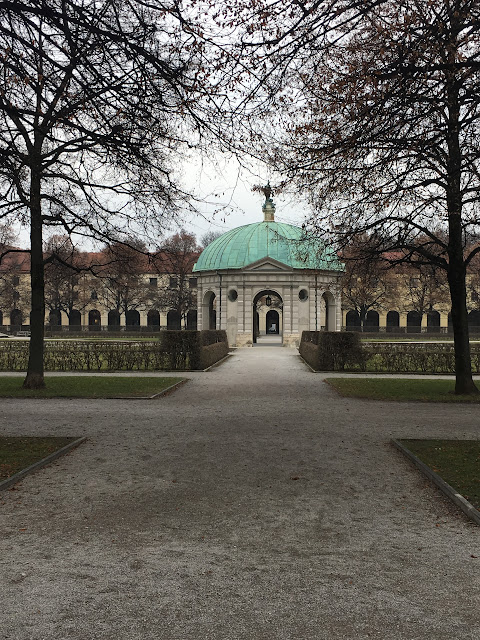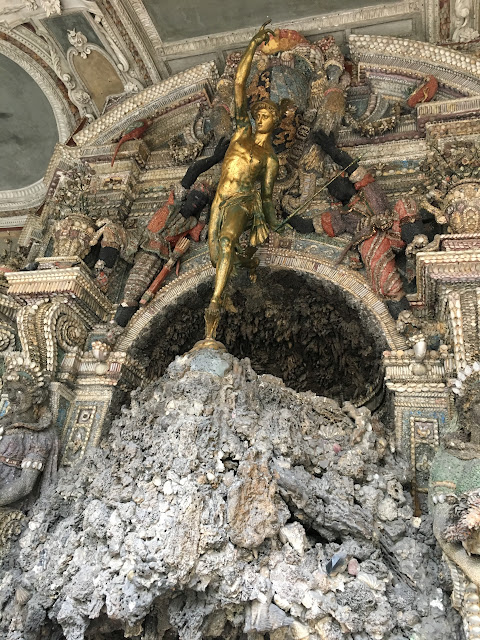The next day in Munich was cold. I mean, they were all cold, but we weren't really used to it yet. We set off bundled in our scarves and hats, headed to the Residenz, the palace where Bavaria's rulers once lived. It's right in the center of town.
The attack on the Christmas market in Berlin was the night before. It was a bit unsettling, for sure, to head back out to crowded tourist areas. But as Rick Steves said, Europe is a continent of 700 million people - 3 million live in Berlin alone - and only 12 people died. No fear! I ended up never actually feeling nervous while we were in Germany. In general it's a very orderly and friendly society which felt familiar to us in an odd way, even though neither of us had been to Germany before. But we did see quite a few policeman in the streets after the attack, and their flags were at half mast.
Anyway, we got a little lost trying to find the Residenz and ended up in a park on what we later learned was the back side of the palace. I'm sure it's a lovely place to hang out when it isn't 27 degrees.
Finally Ben figured out where we were supposed to go. We ended up back on the street near Odeonplatz. Nearly all of these big squares in central Munich were used to hold giant Nazi rallies, which is a hard thing to not think about when you're wandering through there. That's a little Christmas tree lot right in the center of the square.
Once you enter the Residenz, the first thing you see is this giant fountain made completely of seashells. The most interesting thing about it is that, like most of central Munich, it was destroyed in World War II. So they went back out and gathered a bunch more seashells and built it again, for some reason.
This room was also mostly destroyed in World War II.
Most of these were, really. This palace went on and on, with one beautiful room after another, and nearly all of them had a plaque about how it was recreated after being destroyed in World War II.
There was a small Christmas market in the central courtyard of the palace. They were everywhere!
Ben walked all the way down this hall for a photo while a museum employee tried not to pay attention to us.
See:
There was a whole room full of relics - bones and body parts of saints. What a bunch of creeps. This is feet, in case you can't tell.
These rooms were gorgeous - and again, mostly recreated after the war. You have to admire their commitment to their history; in the US we would just raze the whole thing and build some mixed-use condos.
The prince had a giant velvet bedroom that was never actually used as a bedroom. It was just set up to impress visitors.
The last few rooms were all gold leaf and mirrored, which I guess was a hot thing back in the day.
The square at the other side of the palace was also a Nazi hotspot.
It's very picturesque.
And now for something completely different, we hopped on the train to visit the BMW Museum, a quick 20 minute ride outside the city center. Ha ha ha. It turns out that the line we needed was closed halfway there, which took us quite some time to figure out given that we do not speak or read German. Once we finally realized what was going on, we studied the maps for an alternate route, but then that line also didn't seem to be working, and we ended up at some random station where I ended up talking to a man in a sandwich shop to figure out how to get where we wanted to go. It turned out to be a 90 minute odyssey. After this adventure, I downloaded a full German dictionary onto my phone so we didn't have to piece together after twenty minutes of waiting that the sign said "line closed; use the bus instead."
Anyway, BMW has this whole complex out in the suburbs near the 1972 Olympic Park. This big building is called BMW Welt (World). I couldn't really figure out what it was supposed to be from the website and guidebooks.
It turns out to be essentially a big sales showroom. It was interesting to walk through. You can sit in all the cars and talk to employees about them.
You can't go inside the corporate headquarters, but the shorter building next to it is the museum.
Again, Ben was in heaven in this place. In addition to lots of cars, they had exhibits about the evolution of the motors and junk like that.
This was the first place we noticed that Germany is a bit weird about its 20th century history. BMW got its start making motorcycles, and in a display about the history of their manufacture, it says something like "the program was halted in 1944." Oh, you say? Why is that? They just assume you know, I guess.
There is also a whole section on the history of the company and workforce. In vague terms they allude to the fact that "forced labor" was used in BMW factories in the 1930s and 1940s, with the implication that they were somehow compelled to do this. We learned the next day that in fact BMW used huge amounts of slave labor during the Nazi regime, more than virtually any other corporation. After the war, most of its engineers and intellectual property ended up on the East German side of the divide, and it therefore took BMW years to get back up and running at the Bavarian headquarters.
It was interesting to cut back through the BMW Welt to see the modern cars after learning about the evolution of the company.
We headed back to central Munich - much easier now that we understood which metro lines actually were and were not running - and walked to an Indian restaurant for dinner. We needed a break from sausage!

































No comments:
Post a Comment